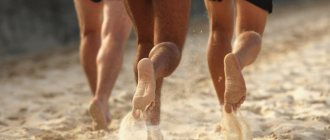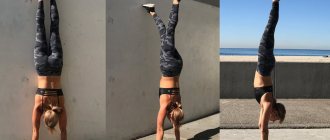Running is one of the most popular workouts for both weight loss and overall health. This is an accessible method of loading that allows you to train in the fresh air, which is especially appropriate during a pandemic. But running mindlessly is also wrong, there are many nuances, knowledge that allows you to get good results: correct heart rate, breathing, degree of load and duration of training. Therefore, below we will consider a running program for beginners, as well as recommendations and tips.
Start by walking
If the last time you ran was at school, and then reluctantly, one flight of stairs causes shortness of breath, or if you are overweight, it is better to start with walking.
For at least a week, aim to walk 10,000 steps every day. It’s just a number, but it’s better to have something to focus on: it makes it easier to start.
Every kilometer you walk improves your fitness and prepares you for your first run. If you lead an active lifestyle and walk a lot, you can immediately start running training.
We set ourselves a goal
To achieve the desired result, you must, first of all, know all the features of a sport such as running and properly prepare for it. The success of any activity depends on desire and moral preparation. If you act purposefully, then positive results will not keep you waiting - the weight will go away gradually and irrevocably. The main thing is to adhere to a certain training schedule, maintain a diet and drinking balance .
REFERENCE! First of all, you need to clearly outline all the benefits of running:
- This is not only an opportunity to lose weight, but also strengthen your health and immunity.
- It is also a great way to get rid of excess weight without exhausting your body with hunger and diets.
- A good opportunity to take a walk in the fresh air, which distinguishes it from working out in the gym.
The goal of running is to lose weight and improve your health, but you need to be careful with the loads; they should be increased gradually, based on the capabilities of your body.
In order to achieve this goal, a person needs motivation.
For some, the motivation may be to strengthen the heart muscle, for others it may be to get rid of cellulite, and for others it may be necessary to put on their favorite clothes again, which show their figure flaws.
IMPORTANT! In addition to all of the above, running, especially in the morning, will provide a boost of vivacity and energy for the rest of the day.
Alternate running with walking
Master of Sports in Athletics and coach Artyom Kuftyrev says that many beginners perceive running as quickly covering a distance, so they quickly run out of steam.
Artyom Kuftyrev
Master of Sports in Athletics, marathon runner, founder of the Instarun running school
On their first run, beginners are frightened by new sensations: the pulse and breathing rate increase, the pressure and speed of blood circulation increase, perhaps somewhere something is stinging out of habit. The body is trying to adapt to the new operating mode, but this takes time. If you endure a little, it will work out and it will be easier for you. But this is only if you chose an adequate pace for yourself from the beginning!
Give your body a chance to adapt: start gradually. Here's an example of a beginner's run-walk workout from our expert.
Set a timer and run for 3 minutes, then walk for the next 2 minutes—that's one set. There are six of them to make in total, which will take you 30 minutes.
However, remember that three minutes of running is not sprinting as hard as you can. You won't last long this way. The running pace should be comfortable.
Artyom Kuftyrev
Master of Sports in Athletics, marathon runner, founder of the Instarun running school
To maintain the right pace, use a simple rule: you must be able to carry on a continuous conversation while running. This pace is also called conversational.
It is often advised to run with an eye on your heart rate, but if you do not have a chest heart rate monitor, it will be of little use. Fitness bracelets and watches determine heart rate very roughly and give huge errors.
Moreover, Artyom claims that the numbers may vary depending on the individual person and at first it is better to focus on your feelings.
If you can't maintain a conversational pace for three minutes, reduce your running time. For example, you can run for 2 minutes and walk for 3, or run for 1 minute and walk the remaining 4.
Don't overexert yourself, check your pace
Coach Fitzgerald outlines three principles of calm running that are recommended to begin with: running comfort, controllability, and the ability to talk while running (in the original, the three “Cs”: comfortable, controlled and conversational).
Avoid extreme discomfort while running: your pace should allow you to carry on a conversation with the person running next to you. If you're running alone, just try saying a long sentence out loud. If you are so fast that you can only blurt out 1-2 words, slow down.
The running pace should allow you to speak freely, and not blurt out 1-2 words.
Train regularly and increase your time
To quickly adapt the body, regular exercise and recovery time are necessary.
Artyom Kuftyrev
Master of Sports in Athletics, marathon runner, founder of the Instarun running school
The most effective growth in training is observed among runners who train 3-4 times a week. If you do workouts every other day, then in two weeks you will complete seven of them. This rhythm will allow you to have time to recover and not lose your skill.
At the same time, to progress, you need to gradually increase your running time. If 3 minutes of running and 2 minutes of walking feels comfortable, use the following plan:
- Week 1: 3 minutes running, 2 minutes walking - 6 series (30 minutes).
- Week 2: 4 minutes of running, 2 minutes of walking - 5 series (30 minutes).
- Week 3: 5 minutes of running, 2 minutes of walking - 4-5 series (28-35 minutes).
- Week 4: 5 minutes of running, 1 minute of walking - 5 series (30 minutes).
- Week 5: Full 30 minutes of running without walking.
- Week 6: 35 minutes of running.
- Week 7: 40 minutes of running.
- Week 8: 45 minutes of running.
If you feel very tired before finishing your workout as planned, you are either running too fast or running too long.
Go back and repeat the previous week again, and then try again. And under no circumstances should you quit under the pretext: “After all, running is not my thing.” You just need more time to adapt.
If you continue, you have already won.
Supercompensation principle
Before drawing up a training schedule, it is necessary to understand what processes occur in the body in various phases of the training process.
Let's highlight 5 phases of the training process:
- Traumatization. Muscle fibers are injured by the load, the body receives stress from the workout, with the help of which muscles will be gained, the fat burning process will start, and physical data will improve. Muscles don't grow during training! Fat doesn't burn! Stamina does not increase! Training is the trigger for starting the processes that will help you achieve the goals listed above.
- Rapid recovery phase. Lasts 30-90 minutes after completion of the workout. The nervous system is restored, the level of anabolic and stress hormones returns to normal (not completely). In this phase, it is necessary to give the body rest. It is advisable not to be too active, to nourish the body with quickly digestible food. Those who want to gain muscle mass can use chocolate, bananas, milk, eggs. When losing weight, it is better to either refuse food altogether, move the meal within 90-180 minutes after training, or use amino acids, which will slightly speed up fat burning while maintaining muscle mass.
- Slow recovery phase. Lasts until the body is completely restored to pre-workout levels. Read more about how to recover after a workout here.
- Supercompensation phase. The body is restored to pre-workout levels and creates a “reserve” - additional opportunities to overcome similar stress with less effort. This “reserve” can be expressed in the form of gained muscle mass, 200 grams of fat lost, or improved functioning of the musculoskeletal system. When the body has created a “reserve” for a less stressful previous workout, we can do a little more - increase the load so that the next time the body is adapted to new indicators. This is the principle of load progression, which can only be implemented in the supercompensation phase.
- Loss of super compensation. If an athlete does not train in the supercompensation phase, the body stops spending energy to maintain the “reserve”. The athlete returns to the indicators that he had before the training.
It is critical to train during the supercompensation phase!
Training should be carried out only in the supercompensation phase!
There are special techniques that allow you to train in the recovery phase, in order to then get more supercompensation, and stretch this phase for a longer period.
But there is no point in using these techniques for a beginner.
Signs of the onset of supercompensation are:
- Disappearance of pain in the target muscles.
- Lack of psychological aversion when thinking about training. Desire to train.
- The ability to do more work than in the previous workout.
Example: today you were able to run for 15 minutes, after which your body refused to continue training. During the recovery phase, you will run for 10-12 minutes with the same comfort. After the end of the recovery phase - the same 15 minutes. The basics of supercompensation are 16-18 minutes. After loss of supercompensation – 15 minutes. Training in the supercompensation phase is a slight discomfort. You can squeeze out 17 minutes of running in the recovery phase, but this will be just a “squeeze”, and not progress with slight discomfort, as in the supercompensation phase.
Training in the supercompensation phase is work and pleasure. It’s difficult for you, but the training doesn’t turn into hell, and after the end you get pleasant feelings. In the recovery phase, every step seems like hell, and after training you want to quit everything and never repeat it. It is important to understand this difference in order to seize the moment to train.
Always warm up well before training
Before jogging, always do a joint warm-up.
Artyom Kuftyrev
Master of Sports in Athletics, marathon runner, founder of the Instarun running school
Warm-up exercises activate your body's fundamental motor units and ensure optimal distribution of synovial fluid in your joints, which improves gliding and mobility.
In the video, Artyom Kuftyrev shows a short warm-up that you need to make part of your workout. This is especially important for those who run in the morning, when the body is quite stiff and stiff. Perform the exercises smoothly, without sudden movements.
Correct breathing
Breathing plays a key role in achieving results. The ability of muscles to work effectively depends on the dosage of oxygen, which is delivered in the right quantity at the right time through the blood.
The standard advice that we were told back in school, “inhale through your nose, exhale through your mouth,” stops working when, after running part of the distance, the need arises to take short, frequent inhalations and exhalations. I want to gasp for as much air as possible. On top of everything, it hurts in the side.
A few tricks will help you start running successfully , eliminating unnecessary difficulties.
Inhale through the nose and exhale through the mouth - is this the correct technique? Actually, yes. Ideally, the breathing cycle occurs in this form.
There are several reasons for this.
- Inhalation occurs under the difference in atmospheric pressure between the external environment and the lungs. Thus, inhalation is a voluntary action. Exhalation is forced.
- The inhalation is smooth and longer than the exhalation. The nose is ideal for this task. By exhaling deeply, the lungs empty by 3-4 liters of air and the oral cavity is capable of passing such a volume within a second.
Runners who are not used to breathing correctly may experience dizziness and yawning. Therefore, try to inhale through your nose and exhale through your mouth, but learn this gradually.
If the colitis is on the right, the liver hurts, on the left – the spleen.
The reasons why a stabbing in the side can naturally vary. Usually associated with a load to which the organs have not had time to adapt.
Cool down after your workout
Artyom says that the workout can be completed with dynamic or static stretching. Which one depends on your goals:
- If you're not going to do anything after your run, opt for static stretching.
- If you want to end your run with circuit strength training or jumping exercises, do dynamic stretching. This is a set of multi-joint exercises that will help you warm up your body more thoroughly, prepare it for other movements and reduce the risk of injury.
How to do static stretching
Static stretching is when you take a certain position in which the muscles are stretched and hold it for some time. It will help relax the major muscle groups that worked while running. In the video below, our expert shows a set of stretching exercises after a run.
Hold each position for 45–60 seconds, stretch without fanaticism (pain should be minimal).
How to do dynamic stretching
Dynamic stretching is a set of multi-joint exercises that help stretch your muscles more thoroughly. It will help you avoid injury during intense movements. In the video below, Artyom shows how to properly perform dynamic stretching.
Unfortunately, not only beginners, but also those who gave themselves a second chance to become a runner after the first failure, ignore warm-up and cool-down, citing lack of time.
Don't skip the warm-up and cool-down: this is as important a part of your workout as the running itself.
It is recommended to warm up before running for about 3-5 minutes
While trainers do not recommend stretching before running, warming up before running is, on the contrary, beneficial. A warm-up warm-up will moisturize your joints, increase your heart rate, and prepare your blood vessels, cardiovascular and nervous systems for stress. Warming up also reduces the risk of injury.
Here's an example of a 3-minute dynamic warm-up before running:
However, there are options without wallowing on clean, warm grass (this is especially true if there is none). Therefore, here is the second option for warming up before running from the nogibogi.com project:
Watch your body position
The quality of your running depends not only on how fast you move your legs, but also on the work of all other parts of your body.
Remember a few simple technical details that you can fix yourself:
- your gaze forward, do not look at your feet.
- Your shoulders need to be relaxed. Many runners strain them, which causes physical fatigue and slows their pace. If you feel that your shoulders are tense, simply shake your arms and try to relax them.
- Your arms should move back and forth like a swing. Do not spread your elbows to the sides, bend them at right angles, make fists with your hands, but do not squeeze them with all your might.
- The feet should be placed under the center of gravity, and not in front of the body. True, this is quite difficult to track (unless you ask to be recorded on video and have your technique analyzed).
It is also very important to learn how to relax your body while running.
Artyom Kuftyrev
Master of Sports in Athletics, marathon runner, founder of the Instarun running school
Most often, novice athletes have excessive tension throughout the body. This interferes with both normal blood flow and the overall running experience. In addition, tension greatly limits the mechanics of movement and entails various inflammations and pain in the legs. Therefore, the main advice: learn to relax while running!
If you want to teach equipment, find a trainer. If you are going to cope on your own, be sure to read about the technical aspects.
Research the question











